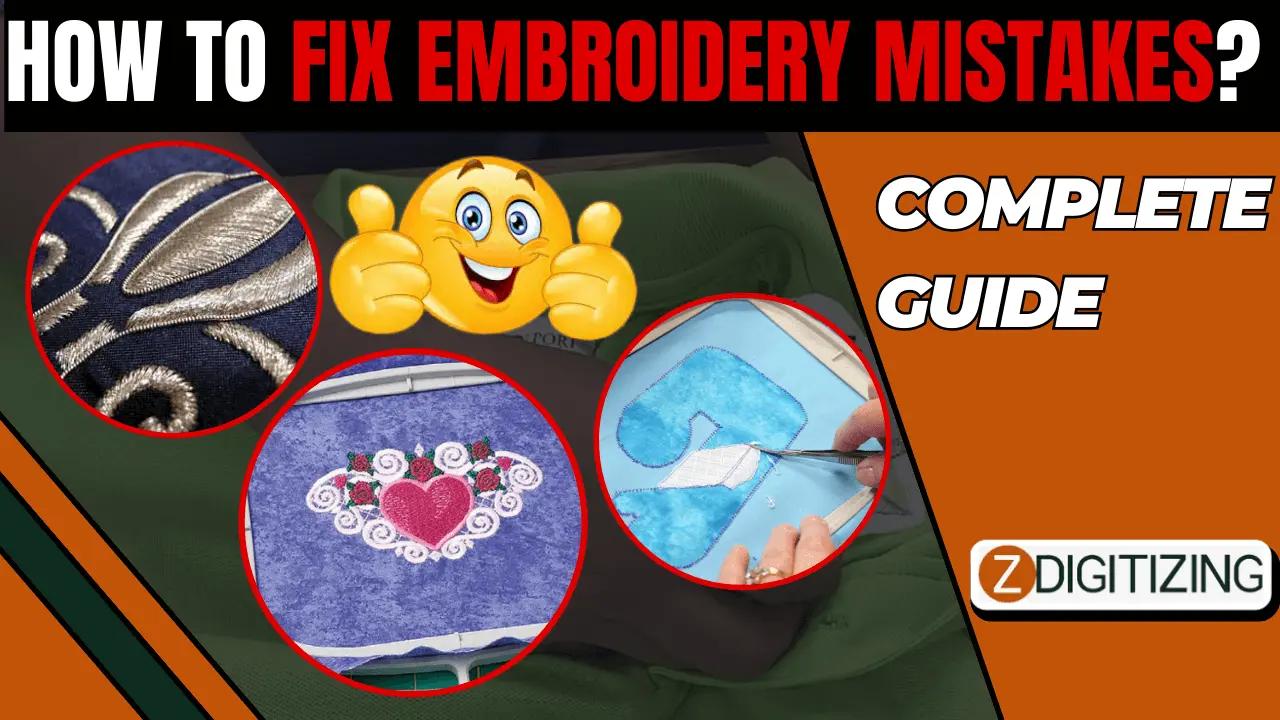Embroidery, a captivating and intricate craft, often involves a delicate dance of precision and creativity. However, even the most experienced embroiderers may encounter mistakes during their projects. Whether it’s a misaligned stitch, a thread tangle, or an unintended design change, the good news is that most embroidery mistakes can be rectified with patience and the right techniques. In this comprehensive guide, we’ll explore common embroidery mistakes and provide a step-by-step guide on how to fix them, ensuring that your embroidery projects turn out flawless.
1. Misaligned Stitches
Common Cause: Misalignment of stitches can occur due to an error in hooping, uneven tension, or machine misalignment.
How to Fix:
- Assess the Misalignment: Identify the direction and extent of the misalignment. This will guide your corrective actions.
- Re-hoop the Fabric: If the misalignment is due to improper hooping, carefully re-hoop the fabric to ensure it is taut and properly aligned.
- Check Tension: Uneven tension can lead to misaligned stitches. Check the tension settings on your embroidery machine and adjust as needed.
- Reposition Design: If the misalignment is consistent across the design, consider repositioning the entire design in your embroidery digitizing software.
2. Thread Tension Issues
Common Cause: Incorrect tension settings on the embroidery machine can result in loose or tight thread tension.
How to Fix:
- Check Bobbin Tension: Ensure that the bobbin tension is correctly set. A bobbin that is too tight or too loose can affect overall thread tension.
- Adjust Upper Thread Tension: Experiment with adjusting the upper thread tension. Make small adjustments and test on a scrap piece of fabric until you achieve the desired tension.
- Use Quality Thread: Low-quality thread can contribute to tension issues. Consider using high-quality embroidery thread for smoother stitching.
3. Thread Breakage
Common Cause: Thread breakage can occur due to various reasons, including dull needles, improper threading, or insufficient tension.
How to Fix:
- Change the Needle: A dull or damaged needle is a common cause of thread breakage. Replace the needle with a new, sharp one.
- Check Threading: Ensure that the thread is correctly threaded through the machine, including the needle eye and tension discs.
- Adjust Tension: Improper tension can lead to thread breakage. Fine-tune the tension settings on your machine to prevent excessive stress on the thread.
- Use the Right Needle Size: Ensure that you are using the correct needle size for the fabric. A needle that is too small may cause friction and breakage.
4. Puckering or Fabric Distortion
Common Cause: Puckering or distortion of the fabric can result from excessive tension, incorrect stabilizer, or inadequate hooping.
How to Fix:
- Adjust Tension: High tension can cause fabric puckering. Reduce the tension settings gradually until the puckering is minimized.
- Use the Right Stabilizer: Ensure that you are using the appropriate stabilizer for the fabric. Experiment with different stabilizers to find the one that works best for your project.
- Re-hoop the Fabric: If the fabric is not properly hooped, reposition it to ensure even tension and prevent distortion.
5. Unintended Design Changes
Common Cause: Unintended changes to the design can occur due to software glitches, accidental clicks, or misinterpretation of the design layout.
How to Fix:
- Check Design Placement: Ensure that the design is correctly placed within the embroidery hoop. Reposition if necessary.
- Review Software Settings: Double-check the settings in your embroidery software to ensure that the design elements are placed and scaled as intended.
- Backup Design Files: Regularly save backup copies of your design files to prevent data loss. This allows you to revert to a previous version if unintended changes occur.
6. Knots or Tangles in the Thread
Common Cause: Knots or tangles in the thread can result from thread snagging, improper tension, or issues with the bobbin.
How to Fix:
- Remove the Knot or Tangle: Gently remove the knot or tangle without pulling too hard, as this may cause further issues.
- Check Bobbin Area: Inspect the bobbin area for any obstructions, lint, or loose threads that may contribute to tangles.
- Rethread the Machine: Properly rethread the upper thread and ensure that the bobbin is correctly wound and inserted.
7. Stitches Skipping or Missing
Common Cause: Skipping or missing stitches can be caused by a dull needle, incorrect threading, or machine malfunction.
How to Fix:
- Change the Needle: A dull or bent needle can lead to skipped stitches. Replace the needle with a new one and ensure it is properly inserted.
- Rethread the Machine: Incorrect threading can cause stitches to skip. Double-check the threading, making sure it passes through all the necessary guides and the needle eye.
- Check for Machine Malfunctions: Inspect the machine for any malfunctions or issues with the bobbin mechanism. Consult the machine manual for troubleshooting guidance.
8. Design Misalignment on Multiple Hoopings
Common Cause: When working on large designs that require multiple hoopings, misalignment can occur between sections.
How to Fix:
- Use Alignment Markers: Implement alignment markers or registration points in your design and on the fabric to ensure accurate placement during multiple hoopings.
- Measure and Mark: Measure and mark reference points on the fabric before rehooping to maintain consistency between sections.
- Overlap Stitches: Overlap stitches between sections to create a seamless transition and prevent gaps in the design.
9. Fading Colors or Color Bleeding
Common Cause: Fading colors or color bleeding can result from using low-quality thread, inadequate stabilizing, or improper laundering.
How to Fix:
- Use High-Quality Thread: Invest in high-quality embroidery thread that retains color vibrancy and resists bleeding.
- Stabilize Appropriately: Ensure that you are using the correct stabilizer for the fabric and design. Proper stabilization prevents distortion and color bleeding.
- Test Colorfastness: Before laundering the embroidered item, test the thread’s colorfastness by placing a small, inconspicuous portion in water. If the colors bleed, take precautionary measures during washing.
Conclusion
Embroidery mistakes are a natural part of the creative process, but with the right knowledge and techniques, they can be effectively addressed. Whether you’re a novice or a seasoned embroiderer, encountering challenges is an opportunity to refine your skills and learn from the experience. By understanding the common causes of embroidery mistakes and following the steps outlined in this comprehensive guide, you can confidently navigate and overcome challenges, ensuring that your embroidery projects are a testament to skill, precision, and creativity.
Remember, embroidery is as much about the journey as it is about the destination. Embrace the learning process, experiment with different techniques, and let each project contribute to your growth as an embroiderer.
Zdigitizing
We trust this article might really work out for you. To digitize embroiery plan you would require an expert like ZDigitizing, as digitizing is a mind boggling process.
Zdigitizing is a digitizing embroidery organization that gives total digitizing and vector craftsmanship benefits all around the world to organizations, ventures, and enterprises. Zdigitizing gives fashionable, strong, and sensible custom digitizing embroidery and vector craftsmanship administrations. We have been conveying first class digitizing embroidery administrations for 20+ years.
If you are looking to digitize your embroidery designs, ZDigitizing is a reliable and professional company that provides complete digitizing and vector art services worldwide.
With a quick turnaround time and excellent quality, ZDigitizing is a great choice for your digitizing needs.
Hope it will be helpful for you guys!
If there’s any question related to this article you can simply ask in the comment section and don’t forget to share with those you think might be helpful for them.
And finally, thanks for reading!
FAQs
-
Can all embroidery mistakes be fixed?
- While many embroidery mistakes can be fixed, the extent of correction may vary. Some mistakes may be easier to address than others. Patience and attention to detail are key in the correction process.
-
How can I prevent embroidery mistakes in the first place?
- Preventing embroidery mistakes involves careful planning, using quality materials, maintaining machine and needle health, and practicing good embroidery habits. Regularly reviewing and testing designs before stitching can also help identify potential issues.
-
Should I seek professional help for complex embroidery mistakes?
- For complex or persistent embroidery mistakes, seeking advice from a professional embroiderer or technician may be beneficial. They can provide insights, troubleshoot issues, and offer solutions based on their expertise.
-
Is it common to encounter mistakes in embroidery projects?
- Yes, it is common for embroiderers, both beginners and experienced, to encounter mistakes during projects. Mistakes are a natural part of the learning process and offer opportunities for improvement and skill development.
-
Can embroidery mistakes be disguised or incorporated into the design creatively?
- Yes, some embroidery mistakes can be creatively disguised or incorporated into the design. This approach requires a creative mindset and the ability to adapt the design to make the mistake appear intentional and artistic.





